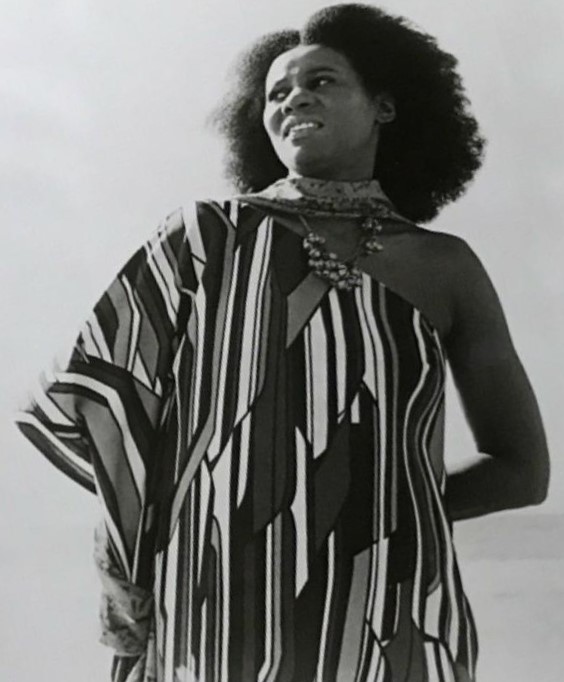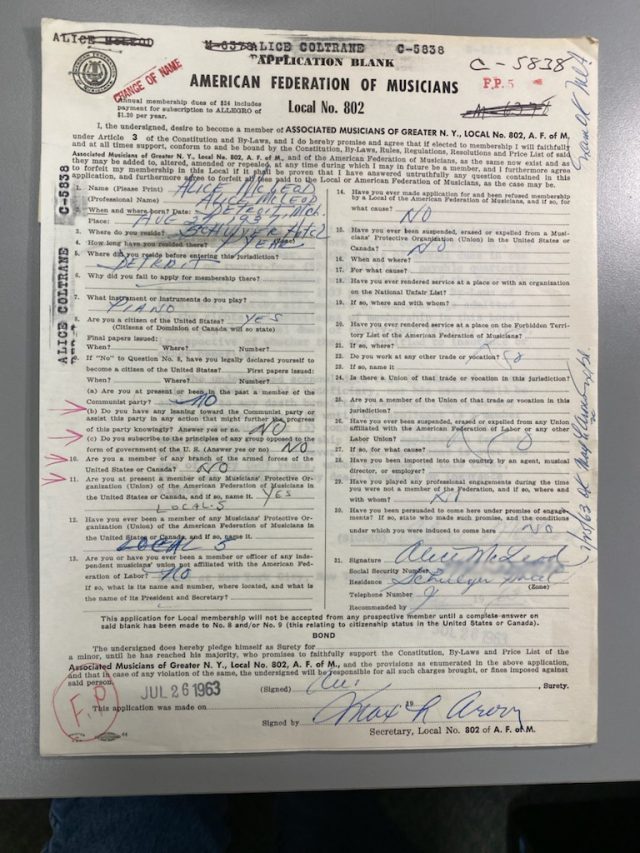Allegro
A tribute to Alice Coltrane (1937-2007)
Volume 124, No. 3March, 2024

Local 802 member Alice Coltrane (1937-2007)
Bearing the surname of a jazz messiah, pianist, organist, harpist, and Local 802 member Alice Coltrane Turiyasangitananda (1937-2007) overcame the virulent sexism of her time to stand as a giant in her own right.
Born into the musical McLeod family in Detroit on August 27, 1937, young Alice quickly took to keyboard instruments and, by the age of nine became an organist at neighboring Mt. Olive Baptist Church, where her mother was a choir member. Formerly studying piano, she delved deeply into the jazz scene at home before traveling to Paris where she took invaluable tutelage with Bud Powell, performing at that city’s Blue Note and on French television with noted expats Lucky Thompson and Kenny Clarke.
Relocating back to the U.S., her reputation grew as part of Terry Gibbs’ quartet which, in 1963 — the year she joined Local 802 – -played a double bill with John Coltrane at Birdland. She and the saxophonist became inseparable, marrying in 1965 (when her union membership was modified with a “change of name” to Alice Coltrane). By the mid-60s John Coltrane, already the progressive eminence in jazz, began vastly expanding his own palette and that of his band, which she joined as pianist a year later, replacing the exiting McCoy Tyner. Later, Alice Coltrane would state: “…Before I even met him and became part of the group and part of his life, there was something in me that knew that there is a spiritual, musical connection, a divine connection, with this person. Because there were things that he said to me, they weren’t spoken with the human voice…” (https://www.alicecoltrane.com/life )

Alice Coltrane’s application to join Local 802 in 1963
Spirituality became a major exponent in the creativity of both Coltranes, with eastern philosophy and culture, meditation, prayer and praise in many shapes lifting the music to previously unexplored realms. In ‘66 she was signed to Impulse Records as a solo artist. Through this period and John Coltrane’s tragic 1967 death, Alice Coltrane incorporated the harp into the band and particularly into her own work. By the later ‘60s, widowed, she reflected still deeper into spirituality, becoming a practitioner of Integral Yoga teachings by Sri Swami Satchidananda, (who opened the Woodstock Festival in 1969), visiting India for retreat and study. Even as she maintained a music career, Coltrane considered her life’s work to be “in service to God” and later founded the Vedantic Center in Santa Monica to share her teachings and lead others in prayer, song and healing.
“…One of the directives given to me was to start the ashram. I felt I could serve in any way that God wished. Whatever was ordered, I would have been happy to follow. My idea was to have the availability to seek the Lord, to be able to study spiritual scriptures, and to really immerse myself in living the spiritual life as much as possible…” (https://www.alicecoltrane.com/life )
Coltrane released several noted albums and collaborated with many of the most expansive musicians of the day including Ornette Coleman, Charlie Haden, Roy Haynes, Pharaoh Sanders, Jack DeJohnette and initially, John Coltrane via Cosmic Music, released not long after his death. Alice’s Monastic Trio offered new paths for the exploratory nature of this music, grown directly from John’s last ensemble, featuring Pharaoh Sanders, Jimmy Garrison, and Rashid Ali (with Ben Riley on some cuts) along with this leader’s harp and organ.
Carrying the music and message into large-scale compositional structures, but still shaping the work through improvisation, Coltrane would come to release another 20 albums, some featuring mass choruses, orchestral settings, world fusion, solo organ or harp pieces, some purely of devotional music, others were fiery combos closer to the vision of ‘67.
In the 1980s, Coltrane focused entirely on spirituality, largely out of public view, but then in 2004, released comeback recording Translinear Light to critical acclaim. This brought about re-releases of some of her albums and the launch of compilations, as well as a limited tour highlighted by several festival appearances. The sad irony is that Alice Coltrane, at the top of her newfound celebrity, as multiple artists sang due praises, would pass away just three years later. She was 69 years old.
An artist whose palette overran the spectrum that few have borne witness to, Alice Coltrane had the unique gift of seeing in all directions simultaneously while never looking back.
(This month, the previously unavailable “Alice Coltrane – Live at Carnegie Hall,” a spectacular capture from 1971, will be released by the Verve label as part of 2024’s Year of Alice initiative of the John & Alice Coltrane Home on Long Island. Click here for more information on the recording.)
Local 802 Organizing Director John Pietaro is a published writer and poet.
RECENT NEWS ON ALICE COLTRANE
